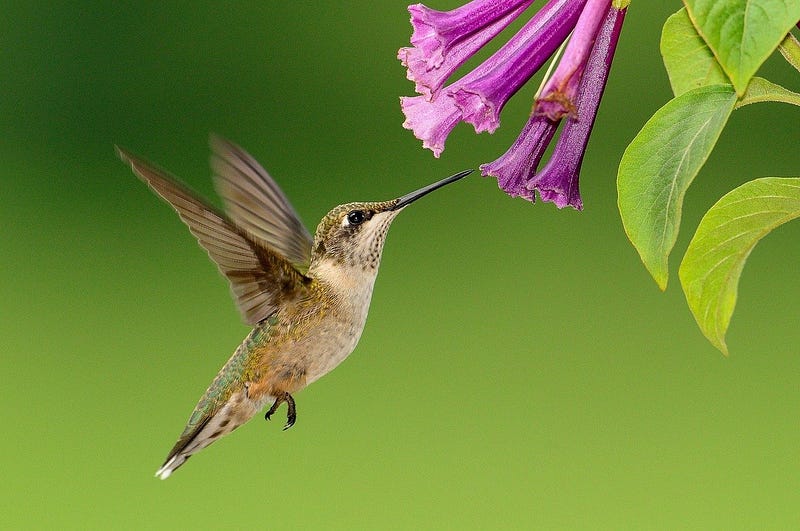A Fleeting Glimpse: The surprising complexity of hummingbird displays
By Rachel Lines, Behavioral Neuroscience, 2023

Has a quick flash of color at your bird feeder ever caused you to do a double take? While anyone who has glimpsed the quick movement and fantastic colors of a hummingbird can appreciate their natural beauty, the true marvel of this species comes from their distinct adaptations. The evolution of many bird species is driven by sexual selection, in which the females of the species select mates who demonstrate their strengths and abilities. This process has resulted in many spectacles of nature, such as male birds performing complicated dances or building elaborate nests to impress females. Recently, scientists have evaluated the molecular and structural basis of these hummingbirds displays, and analyzed the role of sexual selection in the evolution of flashy, iridescent colors and pitch production through the movement of feathers on their wings.
The complex coloration of hummingbird feathers can be viewed when the bird moves and changes the angle from which the viewer is observing. From the side perspective, the feathers may appear dull. However, when the bird is turned at a specific angle, the iridescence of the feathers is brightly displayed. Spanning the entire rainbow, hummingbirds have immense color variation between species. Male hummingbirds tend to exhibit large, flashy patches of colors with more prevalence than females.
What makes hummingbirds so distinctly colorful, unlike other bird species? An analysis of hummingbird feathers by researchers at the Field Museum in Chicago revealed that structure has a role to play in the colors. The cells in bird feathers contain melanosomes, or pigment-producing organelles. Human cells also have melanosomes, which produce melanin in hair and skin. After examining the feathers of 35 different hummingbird species using transmission electron microscopy and measuring reflectance spectra, researchers found that hummingbird melanosomes don’t merely produce pigment as human melanosomes do. These organelles in hummingbirds are layered and shaped differently in comparison to humans, as well as other bird species. Some bird species have melanosomes that are organized into hollow structures or are completely solid, but hummingbirds have flattened, hexagon-shaped melanosomes containing tiny air bubbles. Through the interactions of light with this complex surface, hummingbirds are able to display brilliant color. Hummingbird color variation can also be explained through evaluation of this structure — the complexity of the structure and traits allows for more phenotypic variation.
Hummingbird feathers are more than just a sight to be seen. Several hummingbird species are also capable of producing sound using only the fast movement of their feathers. Utilizing a phenomenon called aeroelastic flutter, the shape of individual feathers allows hummingbirds to manipulate their flight and oscillate to create attention-grabbing sounds during mating displays. Through differences in feather size, shape, mass, and stiffness, the resonance frequency of the feather changes. Furthermore, hummingbirds can produce multiple sounds from different locations. The Allen’s hummingbird, for example, can produce two tail tones and a wing tone simultaneously while performing a diving display.
Several hummingbird species are also capable of producing sound using only the fast movement of their feathers.
Scientists have wondered why hummingbirds exhibit these exceptional traits and how they evolved. The appearance of these colors and abilities in the male individuals of the species suggest that these traits may have adapted due to sexual selection. Hummingbirds have long been a subject of discussions about the relationship between natural and sexual selection. In 1867, G. D. Campbell criticized Charles Darwin’s theory of natural selection because he claimed it was not adequate to explain the brilliance of hummingbird coloring. In response, Darwin suggested sexual selection, in which male-to-male aggression and female choice resulted in the expression of different characteristics.
After analyzing the inheritance interactions between different color patches in hummingbird species, Professor Juan Luis Parra of SUNY Stonybrook found that sexual selection does play a role in the emergence of these distinct traits. However, it was also discovered that color patterns are not completely independent of one another. The adaptations that result from natural selection and from sexual selection interact, producing the displayed phenotype. Parra suggests that the overall coloration and species diversity in hummingbirds is affected by sexual selection, but other mechanisms such as natural selection and geographic isolation may also be essential contributors.
Hummingbird feathers are complex in their structure and function, resulting in incredible diversity throughout the species. Beyond a pretty image at your bird feeder, these creatures are specifically evolved to be eye-catching, attracting mates through their elaborate visual and audio displays. In the fleeting moment before they fly away, hummingbirds briefly reveal this beauty to human onlookers, but their true range of attention-grabbing skills remain mysterious, concealed from the average observer.
Science (2011). DOI: 10.1126/science.1205222
Evolution (2010). DOI: 10.1111/j.1558–5646.2009.00827.x
Evolution (2015). DOI: 10.1111/evo.12575
